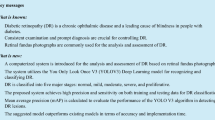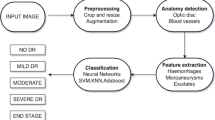Abstract
Diabetic retinopathy (DR) is leading cause of blindness among diabetic patients. Recognition of severity level is required by ophthalmologists to early detect and diagnose the DR. However, it is a challenging task for both medical experts and computer-aided diagnosis systems due to requiring extensive domain expert knowledge. In this article, a novel automatic recognition system for the five severity level of diabetic retinopathy (SLDR) is developed without performing any pre- and post-processing steps on retinal fundus images through learning of deep visual features (DVFs). These DVF features are extracted from each image by using color dense in scale-invariant and gradient location-orientation histogram techniques. To learn these DVF features, a semi-supervised multilayer deep-learning algorithm is utilized along with a new compressed layer and fine-tuning steps. This SLDR system was evaluated and compared with state-of-the-art techniques using the measures of sensitivity (SE), specificity (SP) and area under the receiving operating curves (AUC). On 750 fundus images (150 per category), the SE of 92.18%, SP of 94.50% and AUC of 0.924 values were obtained on average. These results demonstrate that the SLDR system is appropriate for early detection of DR and provide an effective treatment for prediction type of diabetes.






Similar content being viewed by others
References
Abdel-Hakim AE and Farag AA (2006) CSIFT: A SIFT descriptor with color invariant characteristics. IEEE computer society conference on computer vision and pattern recognition 1978–1983
Acharya UR et al (2016) Novel risk index for the identification of age-related macular degeneration using radon transform and DWT features. Comput Biol Med 73:131–140
Ahmad Fadzil MH et al (2011) Analysis of retinal fundus images for grading of diabetic retinopathy severity. Med Biol Eng Comput 49(6):693–700
Akram MU et al (2014) Detection and classification of retinal lesions for grading of diabetic retinopathy. Comput Biol Med 45:161–171
Bay H, Tuytelaars T, Van Gool L (2006) SURF: speeded up robust features. Computer vision. Lect Notes Comput Sci 3951:404–417
Bertolini D et al (2013) Texture-based descriptors for writer identification and verification. Expert Syst Appl 40(6):2069–2080
Bhaskaranand M et al (2016) Automated diabetic retinopathy screening and monitoring using retinal fundus image analysis. J Diabet Sci Technol 10(2):254–261
Datta NS, Dutta HS, Majumder K (2016) Brightness-preserving fuzzy contrast enhancement scheme for the detection and classification of diabetic retinopathy disease. J Med Imaging 3(1):1–10
Early Treatment Diabetic Retinopathy Study Research Group (1991) Grading diabetic retinopathy from stereoscopic color fundus photographs-an extension of the modified Airlie House classification. ETDRS report number 10. Ophtalmology 98:776–806
Faust O et al (2012) Algorithms for the automated detection of diabetic retinopathy using digital fundus images: a review. J Med Syst 36(1):145–157
Ganesan K et al (2014) Computer-aided diabetic retinopathy detection using trace transforms on digital fundus images. Med Biol Eng Comput 52(8):663–672
Guo Y, Zhao G, Pietikinen M (2012) Discriminative features for texture description. Pattern Recogn 45(10):3834–3843
Hanley JA, McNeil BJ (1982) The meaning and use of the area under a receiver operating characteristic (ROC) curve. Radiology 143(1):29–36
Hinton GE (2002) Training products of experts by minimizing contrastive divergence. Neural Comput 14:1771–1800
Hinton GE (2010) A practical guide to training restricted boltzmann machines. Tech. Rep. UTML TR 2010-003, Department of Computer Science, University of Toronto. https://www.cs.toronto.edu/~hinton/absps/guideTR.pdf. Accessed 4/1/2015
Hinton GE et al (2012) Deep neural networks for acoustic modeling in speech recognition: the shared views of four research groups. IEEE Signal Process Mag 29(6):82–97
Ibrahim S et al (2015) Classification of diabetes maculopathy images using data-adaptive neuro-fuzzy inference classifier. Med Biol Eng Comput 53(12):1345–1360
Kandemir M, Hamprecht FA (2015) Computer-aided diagnosis from weak supervision: a benchmarking study. Comput Med Imaging Graph 42:44–50
Keshavan MS (2017) Sudarshan M (2017) Deep dreaming, aberrant salience and psychosis: connecting the dots by artificial neural networks. Schizophr Res S0920–9964(17):30029–33034
Lazebnik S, Schmid C, Ponce J (2006) Beyond bags of features: spatial pyramid matching for recognizing natural scene Categories. IEEE computer society conference on computer vision and pattern recognition, pp. 2169–278
Lee J, Zee BC, Li Q (2013) Detection of neovascularization based on fractal and texture analysis with interaction effects in diabetic retinopathy. PLoS ONE 8(12):e75699
Li B, Li HK (2013) Automated analysis of diabetic retinopathy images. Curr Diab Rep 13(4):453–459
Li Y et al (2015) A survey of recent advances in visual feature detection. Neurocomputing 149:736–751
Lin J (1991) Divergence measures based on the Shannon entropy. IEEE Trans Inf Theory Arch 37(1):145–151
ManjulaSri R, Raghupathy RM, Rao KMM (2014) Image processing for identifying different stages of diabetic retinopathy. Int J Recent Trends Eng Technol 11:83–92
Mikolajczyk K, Schmid C (2005) A performance evaluation of local descriptors. IEEE Trans Pattern Anal Mach Intell 10(27):1615–1630
Mishra PK et al (2014) A computational modeling for the detection of diabetic retinopathy severity. Bioinformation 10(9):556–561
Mookiah MRK et al (2013) Computer aided diagnosis of diabetic retinopathy using multi-resolution analysis and feature ranking frame work. J Med Imaging Health Inform 3(4):598–606
Mookiah MRK et al (2013) Computer-aided diagnosis of diabetic retinopathy: a review. Comput Biol Med 43(12):2136–2155
Mookiah MR et al (2014) Decision support system for age-related macular degeneration using discrete wavelet transform. Biol Eng Comput 52(9):781–796
Nayak J et al (2008) Automated identification of diabetic retinopathy stages using digital fundus images. J Med Syst 32(2):107–115
Pires R et al (2014) Advancing bag-of-visual-words representations for lesion classification in retinal images. PLoS ONE 9(6):e96814
Prakash NB, Selvathi D, Hemalakshmi GR (2014) Development of algorithm for dual stage classification to estimate severity level of diabetic retinopathy in retinal images using soft computing techniques. Int J Elect Eng Inform 6(4):717–739
Rodriguez-Poncelas A et al (2015) Prevalence of diabetic retinopathy in individuals with type 2 diabetes who had recorded diabetic retinopathy from retinal photographs in Catalonia (Spain). Br J Ophthalmol 99:1628–1633
Schmidhuber J (2015) Deep learning in neural networks: an overview. Neural Netw 61:85–117
Teng T, Lefley M, Claremont D (2002) Progress towards automated diabetic ocular screening: a review of image analysis and intelligent systems for diabetic retinopathy. Med Biol Eng Comput 40(1):2–13
Thomas S et al (2013) Deep neural network features and semi-supervised training for low resource speech recognition. In: Proceeding of IEEE international conference on acoustics, speech and signal processing, Vancouver, BC, pp. 6704–6708
Ting DS, Cheung GC, Wong TY (2016) Diabetic retinopathy: global prevalence, major risk factors, screening practices and public health challenges: a review. Clin Exp Ophthalmol 44(4):260–277
Van de Sande KE, Gevers T, Snoek CG (2010) Evaluating color descriptors for object and scene recognition. IEEE Trans Pattern Anal Mach Intell 32(9):1582–1596
Verma K, Deep P, Ramakrishnan AG (2011) Detection and classification of diabetic retinopathy using retinal images. In: Proceeding of 2011 annual IEEE India conference (INDICON), pp 1–6
Washington RE et al (2014) All-cause mortality in a population-based type 1 diabetes cohort in the U.S. Virgin Islands. Diabetes Res Clin Pract 103(3):504–509
Welikala RA et al (2015) Genetic algorithm based feature selection combined with dual classification for the automated detection of proliferative diabetic retinopathy. Comput Med Imaging Graph 43:64–77
Wong LY et al (2008) Identification of different stages of diabetic retinopathy using retinal optical images. Inf Sci 178(1):106–121
Acknowledgements
This research was supported by the Research and Development Program of Al Imam Mohammad Ibn Saud Islamic University (IMSIU), Saudi Arabia (Grant No. 2006AA02Z347). We would also like to thank two expert ophthalmologists for providing us new private dataset.
Author information
Authors and Affiliations
Corresponding author
Ethics declarations
Conflict of interest
The authors disclosed no potential conflicts of interest.
Rights and permissions
About this article
Cite this article
Abbas, Q., Fondon, I., Sarmiento, A. et al. Automatic recognition of severity level for diagnosis of diabetic retinopathy using deep visual features. Med Biol Eng Comput 55, 1959–1974 (2017). https://doi.org/10.1007/s11517-017-1638-6
Received:
Accepted:
Published:
Issue Date:
DOI: https://doi.org/10.1007/s11517-017-1638-6




